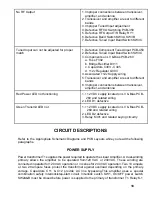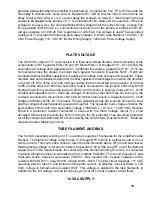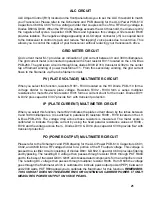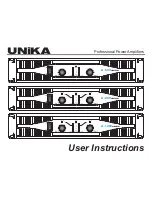
6
UNPACKING AND INSPECTION
The amplifier is shipped in three cartons: amplifier, transformer, tube. Before unpacking each
carton, check the exterior of the shipping carton for any sign of damage. All irregularities should
be noted. Unpack and remove each component carefully from its carton, preserving the factory
packaging as much as possible. Inspect each component for any noticeable defect or damage.
Notify QRO Technologies if any defect or damage is apparent.
TRANSFORMER AND TUBE INSTALLATION
Before performing any of the following installation procedures, make sure that the amplifier
has not been plugged into the AC supply line.
The Amplifier is shipped with the tubes and transformer each shipped in a separate carton. As
part of the installation process, you must install the tube and transformer. You will need the
following tools:
1. Phillips Screwdriver
2. Awl or suitable hole alignment tool
3. Adjustable wrench
Remove the Amplifier's top cover by removing the nine 6-32 x 3/8 Phillips Head machine screws
and their associated flat washers. The sides of the top cover may bend outward when the screws
are removed. This is normal, and they will return when you replace the screws and washers.
TRANSFORMER:
Remove the transformer from its shipping carton. You will notice two
connectors on the ends of the transformer leads. The smaller connector is for the primary leads,
and the larger connector is for the secondary leads. Position the amplifier so the front panel is
facing you. Position the transformer so the primary leads are on your left and the secondary leads
are on your right.The amplifier's transformer compartment should be on the right side. Observe
there are matching primary and secondary leads coming from the amplifier. The primary leads
originate on the back panel, and there are three black leads and three white leads. The nine
secondary leads originate from the center divider panel. The primary and secondary leads of the
transformer and amplifier have matching "mate & lock" connectors. Place the transformer into the
transformer compartment with the secondary leads on the right and the primary leads on the left.
The transformer's four mounting holes should align with the four mounting screws coming out of
the amplifier's bottom panel. Secure the transformer with two 1/4-20 hex nuts on the two right side
mounting screws. Connect the primary and secondary "Mate & Lock" connectors together. Each
connector is indexed so they connect only one way, and you will hear a distinctive click when the
are correctly mated.
Make sure the primary leads coming from the transformer do not
obstruct or prevent the free movement of the cooling fan. Check to see if the step-start
relay contact arm, located on the rear panel just above the cooling fan, has not been placed
out of position during installation. Make a check of all chassis wiring around the
transformer to make sure no wiring has been pinched by the transformer's mounting plate.
Correct any observed problems.
TUBE:
The tube sockets are located on the left side of the amplifier. They have five contacts






































